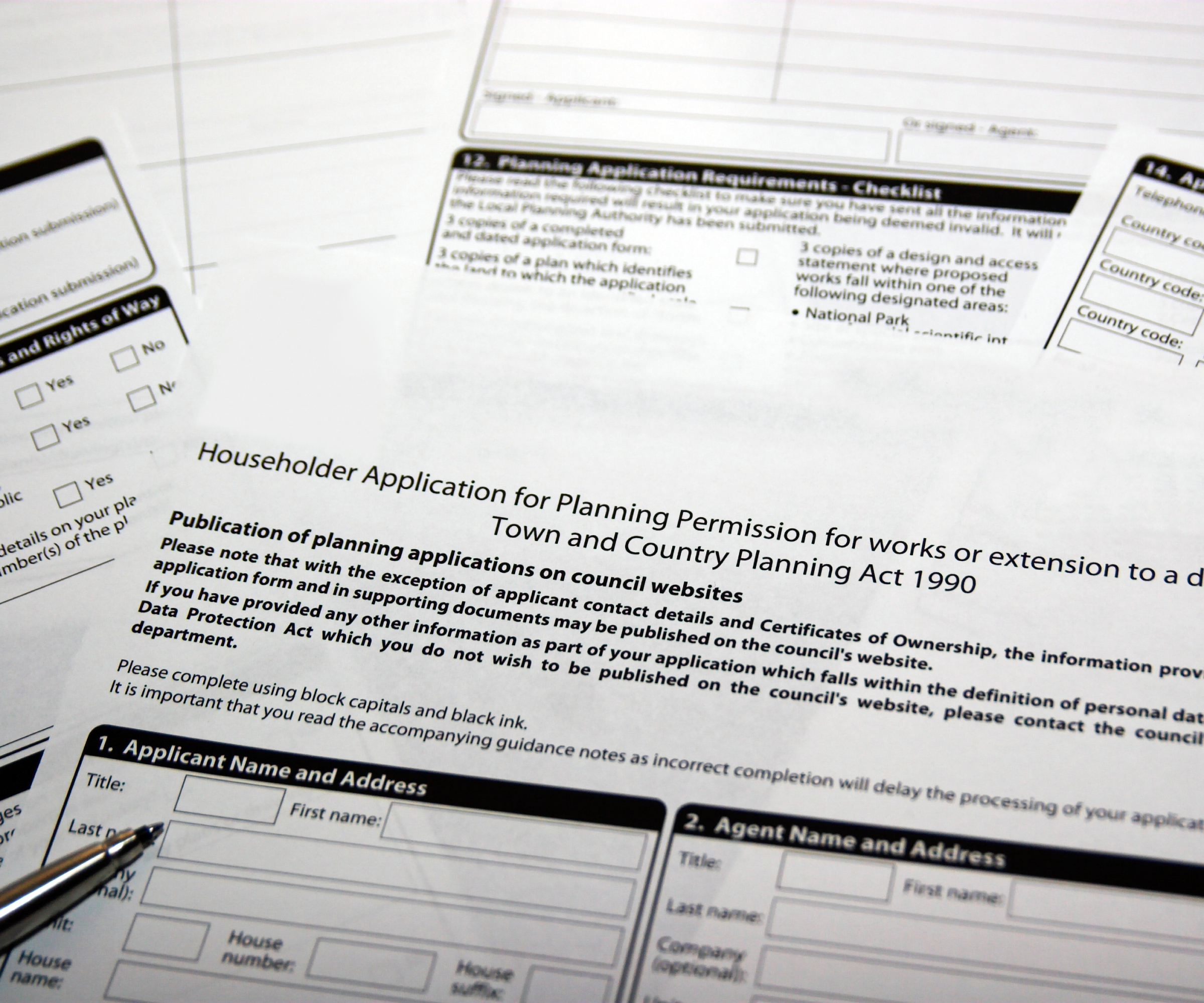Found a self build plot? Follow these 13 steps to assess its potential
Once you've found a self build plot, knowing how to assess its potential is essential to avoid costly mistakes. Follow these 13 important checks before you seal the deal

If you've done your research and think you've finally struck gold in finding a self build plot, there is still a lot to consider before you shake hands on a deal. From planning potential and access issues through to ground conditions, the physical characteristics of the site and the practicality and expense of bringing services to site are all areas that need through investigation.
While the plot may seem perfect on first impressions, it's important to never purchase a development site without first running a series of essential checks and processes to ensure you can build the house of your dreams.
But if you've never self built before, just what do you need to establish? Our guide to assessing the potential of a self build plot will take you through each of the necessary checks in order to help you avoid making costly and painful purchasing mistakes.
Assessing self build plots – plan ahead for success
Above all else, once you've done the groundwork of finding a plot, it’s important to undertake the right checks and processes before offering to buy it, says Sophie O’Reilly, manager of Plotfinder.
“Develop a comprehensive plan as you’ll need to establish all of the following checks and processes before you can even think of proceeding with your self build ideas,” she advises.
So, while you may already have your dream house vision in mind, it's important to take a step back first and ensure the land is suitable and you will ultimately get the planning permission you need – especially if it's a plot that has never been built on before.

13 essential checks and processes when buying a self build plot
While you may think your plot is ripe for development, it can be all too easy to get carried away with the vision while forgetting some of the more practical elements involved in building a house.
So if you're keen to snap up the land before someone else does, here's what our experts advise for assessing its potential.
1. Does the plot have active or expired planning permission?
Although it can seem like a fait accompli if your plot already has planning permission in place, there are still a number of considerations to bear in mind.
“If your chosen plot already has planning permission, make sure it hasn’t expired or is about to expire,” recommends David Snell, one of the UK’s leading self-build and plotfinding experts. “There is no guarantee that you will be able to successfully reapply. Bear in mind, too, that the permission the site actually comes with is unlikely to match your dreams entirely,” he adds.
“There is nothing to stop you continually applying for your chosen design, but the existing design (and approvals process in particular) should give you a good clue as to the possibility of, say, increasing the approval from a bungalow to a two-storey home.
“If you do happen to find a plot that already comes with outline or detailed planning permission, then assess this consent carefully and be sure that if the plot has outline planning permission, that again this hasn’t yet run out. Look at the Design & Access Statement that accompanied the original application to see what the potential of the plot is,” says David.
Once you understand the status of the permission, it's also worth making sure you have answers to the following questions:
- Does the plot have outline planning or detailed/full permission?
- When does the existing consent expire?
- Was planning permission gained at appeal?
- If so, was it because of local opposition or planning department opposition and has this been resolved?
- Are there any planning conditions attached to the building plot (other than the standard) and where possible, have these been satisfied? If not, what still needs to be done?
- Are Permitted Development rights restricted or removed?
- Are there any planning consents on the neighbouring land?
- Is an archaeological survey required?
- Is a watching brief required?


David is one of the UK's leading self build and plotfinding experts, and a serial self builder who has been building homes for 50 years. The author of Building Your Own Home, David spent decades as a speaker and expert at self build exhibitions such as the Homebuilding & Renovating Show. He has recently finished his fourteenth self build project.
2. Are there any local planning rules or other limitations?
Although the recent changes to the National Policy Planning Framework have been designed to help make building your own home easier, there may well still be restrictions in place that could mean you encounter problems.
These can range from larger restrictions such as plans for the area as a whole which may affect property values ((e.g. new roads/motorways/industry moving in or out), through to more site relevant specifics such as the plot being in the curtilage of a listed building, a designated area of outstanding beauty, in a Conservation Area, Area of Outstanding Natural Beauty or National Park or classed as a Site of Special Scientific Interest (SSSI) or higher.
Check the properties around you to see what they look like and if any properties look new or recently extended, check the planning applications to see if they were required to make any changes to their design or had conditions attached that will likely apply to anything you submit too.
3. Is the property in a flood zone?
An increasingly important check given the changing climate and the rise in homes being flooded each year. This will also impact your ability to raise finance and insurance so it is a matter that needs serious consideration and investigation. In a similar vein, you will need to establish if there are any environmental hazards?

4. Rights and restrictive covenants
Be sure to establish if there any usage rights on the land? If a small strip of land – it may only be 150mm wide – between the plot and the highway isn’t included in the plot, it may be a ransom strip,” says David Snell. “A ransom strip may exist to prevent the land being developed. Maybe that is its sole purpose, but more often than not its purpose is to extract payment for its release.
“It comes about most often when a party agrees to sell land with little or no immediate prospect of it being built upon but they want to have some benefit or clawback if it ever does get planning permission in the future. The normal or recognised value of such a ransom strip is one third of the uplift in the value of the land with planning permission over and above its value without it,” he advises.
“Another way of obtaining a clawback is for the land to be sold with a covenant requiring payment of a specified amount or percentage, in the event of it being developed or developed further than originally envisaged. Your solicitor will want to make you aware of such a covenant in their report on title, prior to formal contracts being exchanged.
“However, your solicitor may not be aware of, or may not notice, any discrepancy in the measurements of the land leading to ransom strip,” warns David, “which is why a careful survey is always to be recommended.”
5. Are there any tree preservation orders in place?
Check whether any trees on site are subject to a Tree Preservation Order (TPO). If a plot features a tree – or trees – with a TPO, then any design scheme must take into account the preservation and protection of that tree.
TPOs will affect the design and cost when it comes to building foundations, and in some cases, tree preservation orders (TPOs) can preclude development altogether.
Also check neighbouring properties or land for TPOs and for signs of any being removed and ascertain if there are any protected flora, fauna or wildlife on site.

6. Commission a soil survey
“It’s a good idea to commission a soil survey as soon as possible to determine the ground conditions and subsoil type before carrying out work,” says David Snell. “It is often just as well to also talk to the building inspectors at the local authority – they will have seen everything that has been built in the area and their profound knowledge could end up saving you a fortune in the long run.
“Even in worst-case scenarios, it is unlikely that any extra foundation costs will endanger the viability of the plot. They may, however, restrict what you can build,” he adds. In addition, the ground conditions will also influence the way in which surface water can be disposed of and, if any is required, the type of off mains drainage system that is appropriate.
As a starting point, visit the plot and assess answers to as many of the following questions as possible as this will help when briefing an expert to dig test holes or trial pits.
- What is the natural vegetation?
- Are there any signs of sedge or rush?
- Is there ground water or signs of a high water table?
- In the flowerbeds or disturbed ground is there an indication of subsoil?
- Have any trial pits been dug in the past?
- Is there any rock or heavy clay?
- Are there any streams/watercourses?
- Can you see evidence of filled ground?
- Can you see any signs of any contamination?
7. Look for Japanese Knotweed
When visiting your plot, make sure you know in advance how to identify Japanese Knotweed.
“Japanese knotweed is number one on the list of the UK’s most invasive plant species,” says Nic Seal, MD of Environet. “It can break through cracks in mortar, expansion joints in concrete, splits in drains and joints in paving. The most common form of damage, is caused by laying a hard surface, such as asphalt, concrete, patio slabs and the like, over Japanese knotweed-infested ground.
"Covering over the plant might hide it temporarily, but it won’t solve the problem in the long term," notes Nic. "However, there are a few different methods for eradicating it, and getting a reputable professional in is advisable,” she confirms.

8. Check site access
Before purchase, always ensure that it is possible to fulfill the Highway Department requirements for vehicular access, turning circles and parking to establish if your plot has access issues or not.
Work to the highways can only be undertaken by a contractor that is licensed by the local authority and it is not cheap so make sure you get quotes early on. Establishing any potential problems comes down to a mix of visual and factual information, with the following checklist helpful in establishing what you are dealing with:
- Does the driveway need making up?
- Is it suitable for construction traffic?
- If not, is there alternative/temporary site access?
- Is access obtainable within the site curtilage?
- If not, are the necessary easements in place?
- Will you need Highways consent for such an access?
- Are the ground levels right for gates/bellmouth?
- Is the crossover/drop kerb in place?
- Is there a pavement?
- Is there a grass verge?
- Is the verge part of the highway?
9. Are utilities and drainage in place?
Less relevant if you’re buying a plot with an existing home, but can add lots of extra expense to your budget if you have to bring all the services such as water, electricity, gas, drainage and telecom services to site for your new home.
A ‘plot’ is not a plot without proper access is David Snell’s view. “If it’s got planning permission, then the original application will have included details of the access arrangements. However, never forget that planning says that you may build; it does not say that you can build.
“If there is a legal or physical impediment to you building then that impediment is not overruled by the granting of planning permission,” he warns. “So if there is a need to bring in or pay off third parties in order to obtain an access or visibility splay, this needs to be dealt with before you purchase the plot and any costs should be either paid by the vendors or reflected in the price you pay.
“In a similar vein, principal services such as sewerage will also have been referred to in the application. But just because it says ‘connection to foul water drainage’ does not necessarily confer a right to do so. If a third party agreement has to be made, then this needs sorting out in your favour before you make the purchase,” he recommends.
Your solicitor will need to conduct searches to ensure that any necessary easements are in place for service connections. Conduct any necessary negotiations with neighbours over easements, shared service connections etc. before you purchase the site.
And, if there isn't access to the more traditional mains services, you'll need to establish if the plot is suitable for adding your own such as a borehole, ground source heat pump, septic tank etc. All these will impact your final build costs and may turn a potential plot into a money pit.
10. Consider neighbouring properties and surrounding land
If you're looking to build in a residential area, such as building on a garden plot for example, you'll also need to take a good look around at the surrounding houses and land. Considering the following checklist will help provide you with some essential visual clues that will guide you when it comes to making decisions about your potential project, but also be sure to check all boundary agreements:
- What kind of buildings are in the street scene?
- Are there any new dwellings in the area that give an indication of the planners likes and dislikes?
- Is there a building line?
- What are the general characteristics of local architecture/design
- What are the general architectural features on nearby buildings: e.g. size, shape, form, walling materials, roof covering, roof pitch, roof shape, architectural details
- Is there any sign of structural damage to adjoining buildings?
- Is there any pollution/noise/smell/light from neighbouring properties?
11. Be aware of the physical characteristics of your plot
When assessing a building plot ensure that there are no physical barriers that will prevent development or have a significant influence on development costs. Sloping sites, overhead power lines and existing boundaries may all impact your final build.
A surveyor will be able to check dimensions and gradient as part of a site survey. The ownership of boundaries should be confirmed by your lawyer. To assess the cost of moving telegraph poles/pylons/substations and so on, contact the individual utilities. Take into account any conditions of the sale, such as the erection of boundary fences or walls.

12. Measure the plot yourself
Don't just take the plot description at its word, be sure to measure it yourself in order to establish the full width and length of the plot – particularly if you are looking at a narrow or small plot. Losing 50cm may not seem like much, but could impact on your ground plan or outdoor space.
Also make sure you have taken compass points so you know where the sun rises and sets. If the plot does turn out to have potential, knowing where your sun and shade is will determine your home's orientation and make sure you can access it in the right way.
13. Beware of landbanking
There are a few people prepared to exploit desperate, unworldly plot hunters and relieve them of their money, for maximum profit and minimum outlay. These companies offer what are apparently prime potential plots, for a bargain price.
The catch is that there is no planning approval. It is suggested that, in the fullness of time, the land may eventually get planning approval, and you will then own a prime building plot.
The truth is usually that although the land may get approval one day, it probably never will, and you have wasted your money. If you are considering taking up one of these offers get independent advice first, regardless of how attractive it seems.
Unfortunately, several of these companies will actually refuse to deal with you if you try and take independent advice as to the viability of these sites — which should be all the warning you need.
There is a huge army of seasoned experts out looking for ‘the real thing’, backed by big money from developers who will risk significant capital to acquire the rights to future development land long before it becomes available – sometimes decades in advance. The hard truth is that these bona fide organisations are not going to sell this land to you, but will build their own housing development, because the profit is far bigger.
If anyone offers you a bargain plot, unless they are a generous relative, think again. This is now usually referred to as ‘landbanking’.
FAQs
How much should I pay for a self build plot?
When it comes to knowing how to value a building plot, the cost of your plot plus your build costs and a 20-30% margin should equal the end value of your finished development. Therefore, an accurate estimate of your build costs is essential to determine how much you should pay for a plot.
“Work out your rough build costs, add them to the plot price and you should end up with a figure that is at least 20% below the estimated value of the finished house (get the selling agent to estimate one for you),” says Jason Orme, managing director of Future PLC's homes portfolio.
“If the end value will be less than the land and reasonable build costs (plus a small profit margin), you will be in a good position to negotiate the plot price down,” he says.
You should also research ceiling values in the area to avoid spending money you cannot recoup. It's well worth checking out Homebuilding & renovating's sister site Plotfinder as it has more than 10,000 plots for sale across the United Kingdom.
This will not only give you a realistic gauge of prices of building plots in your area but you may even see a project that is perfect for you. It's only £5 for a monthly subscription, plus you can sign up to its newsletter that gives a roundup of the best development opportunities each week.
What professionals do I need to hire to assess a self build plot?
“You’ll need a good solicitor experienced in conveyancing for the particular issues that a building plot throws up (as opposed to a house). These include checking for covenants, easements, access, rights of way, and so on,” says Jason Orme. “You should be clear with them about what you want to do – it is then their responsibility to make sure it can happen.”
Assessed your self build plot and think it's the one? Our experts' final tips for getting approval to turn a potential self build plot into your home are to make sure you invest in good design.
“Often, planners are seen as the enemy, or as wanting the most banal of house designs," says Piers Taylor, architect and founder of Invisible Studio Architects. but in my experience, they are far more intelligent than people give them credit for. If the principle accords with policy, planners will usually be delighted to see a well-designed alternative to a dumb, ‘fitting-in’ box. Aim high for the best possible building, with the best possible architect. Good design has real currency here, and will, above all else, help you gain consent.”
Keen to start thinking of self build ideas with an eco-friendly focus? Check out this Passivhaus self build which allowed the owner to combine work and home on one site.
Get the Homebuilding & Renovating Newsletter
Bring your dream home to life with expert advice, how to guides and design inspiration. Sign up for our newsletter and get two free tickets to a Homebuilding & Renovating Show near you.
Michael is Homebuilding & Renovating's Director of Content, Vice Chair of the self build industry body, the National Custom and Self Build Association (NaCSBA), presenter of multiple property TV shows and author of Renovating for Profit (Ebury). He also runs an architectural and interior design practice, offering design and project management services. He is one of the country's leading property experts and has undertaken over 30 building projects including two self-builds and the renovation of a Grade-II listed farmhouse.
Michael has presented over 150 property shows for BBC, ITV1, Channel 5, UK TV Style, and Discovery RealTime, including I Own Britain's Best Home; Don't Move Improve; Trading Up; Good Bid, Good Buy; Build, Buy or Restore?; How to Build A House; and Hard Sell.
Michael is also a regular expert at the Homebuilding & Renovating Shows. He has written for leading British newspapers, including The Daily Telegraph, Sunday Times, Daily Express and The Independent and has appeared on news programmes such as BBC Breakfast.

